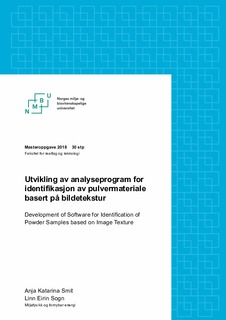| dc.contributor.advisor | Futsæther, Cecilia Marie | |
| dc.contributor.advisor | Tomic, Oliver | |
| dc.contributor.advisor | Kvaal, Knut | |
| dc.contributor.author | Sogn, Linn Eirin | |
| dc.contributor.author | Smit, Anja Katarina | |
| dc.date.accessioned | 2018-10-10T12:14:07Z | |
| dc.date.available | 2018-10-10T12:14:07Z | |
| dc.date.issued | 2018 | |
| dc.identifier.uri | http://hdl.handle.net/11250/2567441 | |
| dc.description.abstract | Kjernefysisk materiale som kommer på avveie skaper uro og bekymring grunnet assosiasjoner som gjerne kobles til anvendelse av slikt materiale, for eksempel knyttet til bruk i kjernefysiske våpen. Beslag av kjernefysisk materiale gir opphav til en rekke spørsmål som må besvares; hvor kommer materialet fra? Hva var det tiltenkte bruksområdet? Hvem eier materialet? Fenomenet som omfatter ulovlig smugling av kjernefysisk materiale og de dertil tilhørende spørsmål, har gitt opphav til et nytt felt kalt Nuclear forensics. Nuclear forensics henspiller på etterforskningen av slikt materiale, der hovedformålet er å identifisere materialets herkomst.
Hovedformålet med denne oppgaven var å utvikle et analyseprogram for bruk til klassifisering av bilder av uranprøver tatt med skanningelektronmikroskop (SEM). Datasettet med SEM-bilder er tatt av uranprøver fra seks forskjellige prosesseringssteder, og gir opphav til seks klasser. Prøvene fra de seks klassene har varierende tekstur og kjemisk sammensetning, hvilket vil gjenspeiles i bildene, og hypotesen er at prøvene fra de seks klassene kan skilles fra hverandre ved hjelp av bildeanalyse. | nb_NO |
| dc.description.abstract | Nuclear material that goes astray creates uncertainty and worry, due to associations often made to the potential uses of such material, for example in nuclear weapons. Seizure of nuclear material prompts a series of questions that need answering: Where does it come from? What was the intended use? Who owns the material? The phenomenon of illegal smuggling of nuclear material and the questions surrounding it has given rise to a new field of research, Nuclear forensics. Nuclear forensics alludes to the investigation of such material, where the main task is to identify the material’s origin.
The primary goal of this thesis was to develop an analysis program for use in classifying images of uranium samples taken with a scanning electron microscope (SEM). The dataset of SEMimages is made up of uranium ore concentrate samples from six different process sites, that form the basis for six classes. The samples from the six classes have different textures and chemical composition, which will reflect in the image. The hypothesis is that the samples from the six classes can be distinguished from one another using image analysis. | nb_NO |
| dc.language.iso | nob | nb_NO |
| dc.publisher | Norwegian University of Life Sciences, Ås | nb_NO |
| dc.rights | Attribution-NonCommercial-NoDerivatives 4.0 Internasjonal | * |
| dc.rights.uri | http://creativecommons.org/licenses/by-nc-nd/4.0/deed.no | * |
| dc.title | Utvikling av analyseprogram for identifikasjon av pulvermateriale basert på bildetekstur | nb_NO |
| dc.title.alternative | Development of software for identification of powder samples based on image texture | nb_NO |
| dc.type | Master thesis | nb_NO |
| dc.description.localcode | M-MF | nb_NO |

